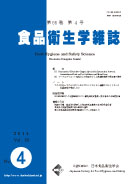All issues

Volume 55 (2014)
- Issue 6 Pages 231-
- Issue 5 Pages 193-
- Issue 4 Pages 167-
- Issue 3 Pages 135-
- Issue 2 Pages 65-
- Issue 1 Pages 1-
Volume 55, Issue 4
Displaying 1-4 of 4 articles from this issue
- |<
- <
- 1
- >
- >|
Original Papers
-
Yusuke IWASAKI, Momoko ODA, Yuri TSUKUDA, Yuki NAGAMORI, Hiroyuki NAKA ...Article type: Original Paper
2014 Volume 55 Issue 4 Pages 167-176
Published: August 25, 2014
Released on J-STAGE: September 11, 2014
JOURNAL FREE ACCESSFood additives, such as preservatives, sweeteners, coloring agents, and flavoring agents, are widely used in food manufacturing. However, their combined effects on the human body are not known. The purpose of this study was to examine whether combinations of antioxidants and metal ions generate reactive oxygen species (ROS) under in vitro conditions using electron spin resonance (ESR). Among the metal ions examined, only iron and copper generated ROS in the presence of antioxidants. Moreover, certain phenolic antioxidants having pro-oxidant activity induced DNA oxidation and degradation via the generation of high levels of ROS in the presence of copper ion, resulting in complete degradation of DNA in vitro.View full abstractDownload PDF (1566K) -
Yoshinori UEKUSA, Hiromi NABESHI, Tomoaki TSUTSUMI, Akiko HACHISUKA, R ...Article type: Original Paper
2014 Volume 55 Issue 4 Pages 177-182
Published: August 25, 2014
Released on J-STAGE: September 11, 2014
JOURNAL FREE ACCESS
Supplementary materialRadioactive contamination in foods is a matter of great concern after the Tokyo Electric Power Company's Fukushima Daiichi nuclear power plant disaster caused by the Great East Japan Earthquake. In order to estimate human intake and annual committed effective dose of radioactive materials, market basket and duplicate diet samples from various areas in Japan were analyzed for cesium-134 (134Cs), -137 (137Cs), and natural radionuclide potassium-40 (40K) by γ-ray spectroscopy. Dietary intake of radioactive cesium around Fukushima area was somewhat higher than in other areas. However, maximum committed effective doses obtained by the market basket and duplicate diet samples were 0.0094 and 0.027 mSv/year, respectively, which are much lower than the maximum permissible dose (1 mSv/year) in foods in Japan.View full abstractDownload PDF (478K)
Note
-
Kaori YOKOTANI, Tomoko NAKANISHI, Tsuyoshi CHIBA, Yoko SATO, Keizo UME ...Article type: Note
2014 Volume 55 Issue 4 Pages 183-187
Published: August 25, 2014
Released on J-STAGE: September 11, 2014
JOURNAL FREE ACCESSAs an adverse event, it has been reported that anticoagulation activity of warfarin was enhanced by simultaneous intakes of glucosamine and chondroitin sulfate. However, it is unclear whether these is a causative relation. Therefore, in the present study, we evaluated whether glucosamine and chondroitin sulfate enhanced the anticoagulant action of warfarin in mice in vivo, focusing on hepatic cytochrome P450 (CYPs)-mediated mechanisms. Mice were fed a diet containing various doses of glucosamine or chondroitin sulfate (0, 0.3, 1% (w/w)) for 2 weeks, and given warfarin by gavage on the last 2 days of the treatment regimen. Doses of glucosamine and chondroitin sulfate were 443 mg/kg and 464 mg/kg in the 0.3% diet groups, and 1523 mg/kg and 1546 mg/kg in the 1% diet groups. We found that 1% glucosamine significantly shortened prothrombin time and thrombotest Owen in animals given warfarin. However, the two ingredients did not induce or inhibit hepatic CYPs, including (S)-warfarin hydroxylase. These findings suggest that glucosamine and chondroitin sulfate do not affect the anticoagulation activity of warfarin through hepatic CYP mediated-mechanisms.View full abstractDownload PDF (517K)
Validation Study
-
Yuhki MAKABE, Hiroshi TAKAHASHI, Tomoko ENOMOTO, Takehiko AIKAWAArticle type: Varidation Study
2014 Volume 55 Issue 4 Pages 188-192
Published: August 25, 2014
Released on J-STAGE: September 11, 2014
JOURNAL FREE ACCESS
Supplementary materialA rapid method for multi-residue determination of pesticides in agricultural products was validated. The sample was cut into pieces and placed into a mixer cup containing half weight amount of 10% phosphoric acid in order to suppress degradation of easily degraded pesticides, represented by captan, and then homogenized. Pesticides in the phosphoric acid-treated sample were extracted with acetonitrile using a homogenizer, followed by salting out with anhydrous magnesium sulfate and sodium chloride. The extract was cleaned up on a C18 and graphite carbon black/PSA mini-cartridge column. Some pesticides gave tailing peaks, but these peaks became sharp and symmetrical when polyethylene glycol (PEG) 300 was added to the test solution. Recovery tests were performed on nine kinds of agricultural products (brown rice, soybean, spinach, cabbage, potato, orange, apple, strawberry, and Japanese pear) fortified with 170 pesticides at 0.01 and 0.1 μg/g. Each concentration of pesticide residue was extracted from 2 samples on 5 separate days. The trueness of the method for 147–164 pesticides in each sample was 70–120% with satisfactory repeatability and within-run reproducibility. This method is expected to useful for multi-residue analysis of pesticides in agricultural products.View full abstractDownload PDF (463K)
- |<
- <
- 1
- >
- >|